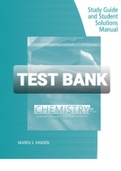Study Guide and Student Solutions Manual Prepared by Jennifer P. Harris Australia • Brazil • Japan • Korea • Mexico • Singapore • Spain • United Kingdom • United States Chemistry for Today General, Organic, and Biochemistry EIGHTH EDITION Spencer L. Seager Weber State University Michael R. Slabaugh Weber State University Copyright 2013 Cengage Learning. All Rights Reserved. May not be copied, scanned, or duplicated, in whole or in part. Due to electronic rights, some third party content may be suppressed from the eBook and/or eChapter(s). Editorial review has deemed that any suppressed content does not materially affect the overall learning experience. Cengage Learning reserves the right to remove additional content at any time if subsequent rights restrictions require it. ȱ
TableȱofȱContents ȱ
GeneralȱChemistry ȱ
Chapterȱ1ȱ Matter,ȱ Measurements, ȱandȱCalculations ȱ 1ȱ
Chapterȱ2ȱ AtomsȱandȱMolecules ȱ 25ȱ
Chapterȱ3ȱ Electronic ȱStructureȱ andȱtheȱPeriodicȱLawȱȱ
Chapterȱ4ȱ ForcesȱBetween ȱParticlesȱȱ
Chapterȱ5ȱ Chemical ȱReactions ȱȱ
Chapterȱ6ȱ TheȱStatesȱofȱMatterȱ 89ȱ
Chapterȱ7ȱ Solutions ȱandȱColloidsȱ 107ȱ
Chapterȱ8ȱ Reaction ȱRatesȱandȱEquilibrium ȱ 12ȱ
Chapterȱ9ȱ Acids,ȱ Bases,ȱ andȱSaltsȱ 145ȱ
Chapterȱ10ȱ Radioactivity ȱandȱNuclearȱProcesses ȱ 1ȱ
OrganicȱChemistry ȱ
Chapterȱ11ȱ OrganicȱCompounds: ȱAlkanesȱ 17ȱ
Chapterȱ12ȱ Unsaturated ȱHydrocarbons ȱ 19ȱ
Chapterȱ13ȱ Alcohols, ȱPhenols,ȱandȱEthersȱ 21ȱ
Chapterȱ14ȱ Aldehydes ȱandȱKetonesȱ 233ȱ
Chapterȱ15ȱ Carboxylic ȱAcidsȱandȱEstersȱ 24ȱ
Chapterȱ16ȱ AminesȱandȱAmidesȱ 263ȱ
Biochemistry ȱ
Chapterȱ17ȱ Carbohydrates ȱ 27ȱ
Chapterȱ18ȱ Lipidsȱ 2ȱ
Chapterȱ19ȱ Proteinsȱ 30ȱ
Chapterȱ20ȱ Enzymes ȱ 31ȱ
Chapterȱ21ȱ NucleicȱAcidsȱandȱProteinȱSynthesis ȱ 3ȱ
Chapterȱ22ȱ Nutrition ȱandȱEnergyȱforȱLifeȱ 33ȱ
Chapterȱ23ȱ Carbohydrate ȱMetabolism ȱ 35ȱ
Chapterȱ24ȱ LipidȱandȱAminoȱAcidȱMetabolism ȱ 36ȱ
Chapterȱ25ȱ Bodyȱ Fluidsȱ 381ȱ
ȱ Answers ȱtoȱtheȱChapterȱSelfȬTestsȱ 3ȱ53
7141
9
67
9
9
7
7
7
91
5
19
345
9
91
iii
Copyright 2013 Cengage Learning. All Rights Reserved. May not be copied, scanned, or duplicated, in whole or in part. Due to electronic rights, some third party content may be suppressed from the eBook and/or eChapter(s). Editorial review has deemed that any suppressed content does not materially affect the overall learning experience. Cengage Learning reserves the right to remove additional content at any time if subsequent rights restrictions require it. Chapter 1: Matter, Measurements, and Calculations 1 CHAPTER OUTLINE 1.1 What Is Matter? 1.2 Properties and Changes 1.3 A Model of Matter 1.4 Classifying Matter 1.5 Measurement Units 1.6 The Metric System 1.7 Large and Small Numbers 1.8 Significant Figures 1.9 Using Units in Calculations 1.10 Calculating Percentages 1.11 Density LEARNING OBJECTIVES/ASSESSMENT When you have completed yo ur study of this chapter, you should be able to: 1. Explain what matter is. (Section 1.1; Exercise 1.2) 2. Explain differences between the terms physical and chemical as applied to: a. Properties of matter (Section 1.2; Exercises 1.10 b & c) b. Changes in matter (Section 1.2; Exercises 1.8 a & b) 3. Describe matter in terms of the accepted sc ientific model. (Section 1.3; Exercise 1.12) 4. On the basis of observation or information given to you, classify matter into the correct category of each of the following pairs: a. Heterogeneous or homogeneous (Section 1.4; Exercise 1.22) b. Solution or pure substance (Section 1.4; Exercise 1.24) c. Element or compound (Section 1.4; Exercise 1.18) 5. Recognize the use of measurement units in everyday activities. (Section 1.5; Exercise 1.28) 6. Recognize units of the metric system, and convert measurements done using the metric system into related units. (Section 1.6; Exercises 1.30 and 1.40) 7. Express numbers using scientific notation, and do calculations with numbers expressed in scientific notation. (Section 1.7; Exercises 1.48 and 1.60) 8. Express the results of measurements and calculat ions using the correct number of significant figures. (Section 1.8; Exercises 1.64 and 1.66) 9. Use the factor-unit method to solve numerical problems. (Section 1.9; Exercise 1.82) 10. Do calculations involving percentages. (Section 1.10; Exercise 1.92) 11. Do calculations involving densities. (Section 1.11; Exercise 1.98) SOLUTIONS FOR THE END OF CHAPTER EXERCISES WHAT IS MATTER? (SECTION 1.1) ;1.2 All matter occupies space and has mass. Mass is a measurement of the amount of matter in an object. The mass of an object is constant regardless of where the mass is measured. Weight is a measurement of the gravitational fo rce acting on an object. The weight of an object will change with gravity; therefore, the we ight of an object will be different at different altitudes and on different planets. 1.4 The distance you can throw a bowling ball will change more than the distance you can roll a bowling ball on a flat, smooth surface. When throwing a ball, gravity pulls the ball toward the ground and air resistance slows its decent. The gravitational force on the moon is approximately 1/6th the gravitational force that is present on the earth; therefore, when throwing a ball on the moon, you should be able to throw it further than you can on earth. The moon does not have air resistance. When ro lling a ball, friction helps to slow down the ball. If the flat, smooth surface is the same on the earth and the moon, the amount of friction should remain constant. Copyright 2013 Cengage Learning. All Rights Reserved. May not be copied, scanned, or duplicated, in whole or in part. Due to electronic rights, some third party content may be suppressed from the eBook and/or eChapter(s). Editorial review has deemed that any suppressed content does not materially affect the overall learning experience. Cengage Learning reserves the right to remove additional content at any time if subsequent rights restrictions require it.




